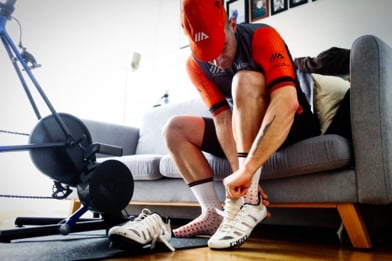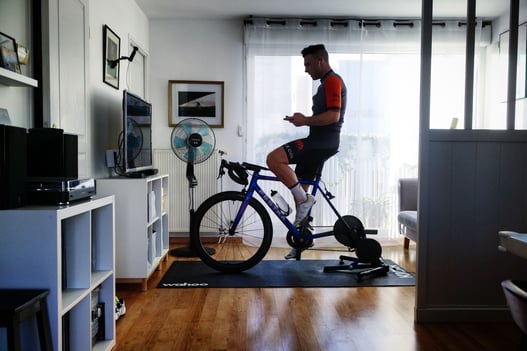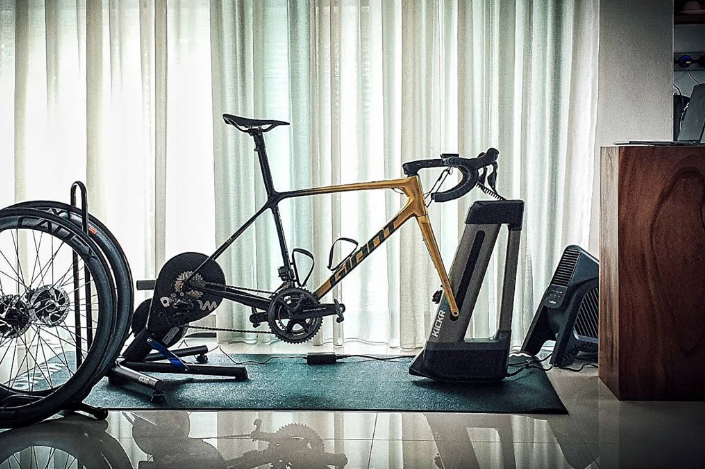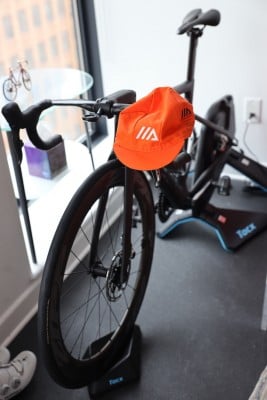We asked our ambassadors for their best tips on how to build the most effective and realistic training setup for serious cyclist.
 Setting up your home trainer
Setting up your home trainer
Home trainers are booming in popularity. But, just like bikes, not all trainers are created equal. Each is made for a particular purpose and different tools can make a huge difference to your overall experience. So we asked some of our ambassadors for their best tips on how to set up your home trainer system to create the most effective and realistic training setup for serious cyclists.
Whether a turbo trainer is an integral part of your training program, or just a way to keep your legs spinning on rainy days, these are eight things you need to know before setting up a home trainer.
Know what you want from your trainer
«You have to know what you really want to do with your trainer,»says Haute Route Ambassador Alexandre Menneteau.
«There are plenty of trainers on the market. Choosing the right one can be difficult. If you are not really comfortable to do it by yourself, don’t hesitate to go to a cycling shop. You will find a person that can help you to choose. If you want it to be realistic, choose an interactive trainer, or at least a smart one. If you want something simple, just to maintain your shape during rainy days or something like that, choose a simple one.»
Not all trainers are the created equal
«There are some important considerations » says Carlos Petricioli, Haute Route Ambassador.
« In general, the larger the fly-wheel, the better road-like experience they offer, but also the more expensive they are. Another important consideration is the way the bike attaches to the trainer. You might not want to attach a high-end carbon road bike to a less secure wheel-on trainer. In terms of measuring power, the more you pay, the best accuracy you get, but honestly most mid-range trainers do well enough. Most mid-range trainers can also simulate climbs up to about 8% gradient, while high-end models go up to 25%. There are trainers for every budget. My recommendation would be to fix a budget and explore the market for the best one out there for you.»
.jpg?width=527&name=Image%20from%20iOS%20(1).jpg) The right tools
The right tools
There are many tools available that can help make your indoor training experience realistic and accurate.
« A power meter and adaptative power resistance are key tools making the home trainer experience more realistic »says, Paul Foulonneau, Haute Route Ambassador.
«Wahoo is offering a climbing simulator, it helps finding the real climbing position while riding in a virtual pass, for instance.»
Calibrate, calibrate, calibrate
«These trainers are very easy to use, but before going hard, calibrate your trainer, » says Menneteau.
«Your watts have to be realistic. If you are at 6W/kg, you have missed your pro career! A heart rate monitor is mandatory to compete with realistic results. Your weight and height measurements should also be perfect. Don’t lie!»
Location is everything
«I recommend a cool part of your home, because with a trainer you enter in the kingdom of sweat,» says Menneteau.
«I chose my garage. You have to be comfortable in the place, with enough space around your bike and trainer. Add a fan; a big one. This is really important. It will be hot and tough.»
Turbo trainers can be noisy
«Another important factor to consider is noise,» says Petricioli.
«The more you pay, the quieter they are. If you live in New York City, like me, or you need to train early in the morning when your family might be sleeping, noise can easily become an important variable.»
You’ve got to clean your bike. Every. Single. Time.
«The worst source of damage to your bike comes from people; sweat,»says Petricioli.
«Sweat is really corrosive to metal and things that are directly exposed like the headset, handlebar or the bottom bracket can get damaged if they are not properly maintained. I have seen broken metal handlebars just from sweat left uncleaned. The bike has to be cleaned before and after you use it, as always! If you have a wheel on, it’s important to have clean tyres, otherwise dirt from the road can damage the trainer and your tyre. If you have a direct drive you need to have a clean chain otherwise your drivetrain will wear faster.»
Wear and tear is real
«Wheel-on trainers will wear your road tyre very fast,» says Petricioli.
«If you have a wheel on you might want to consider using a trainer-specific tyre. Using an old tyre usually does the trick, but if you are constantly switching between riding indoors and outdoors, you might want to consider getting an old/spare wheel to use inside. Other than the tyres, the only potential damage you can get from the trainer is from the attachment. Some use metal parts that directly contact your bike so you might get some wear. Most modern trainers consider this in their design so should be ok. Also, curious fact, most bike manufacturers don’t cover damage when using your bike in a trainer, so its best to be careful.»
Riding inside may be easier
«Riding inside is easier in some ways but harder in others,» says Petricioli.
«For example, it can be very convenient just waking up and hopping onto the trainer vs in some cases having to drive some place to start riding. You can control the weather inside. With smart trainers it can be very easy to do specific workouts. You can upload a workout and the trainer will automatically adjust the resistance.»
However riding inside is also much harder
«Indoor and outdoor training are very different,» says Foulonneau.
«According to me, it is much harder to reach a power zone on the smart trainer. Also, it is a huge mental load to train only indoors. I only do short session of maximum two hours on the home trainer to keep my mind fresh, with targeted exercises (FTP, strength, cadence, etc.)»
Menneteau agrees that the challenge of long indoor sessions is immense.
« During the lockdown I did 15 hours/week on the trainer; the same I would do on the road during a classical week of training,» he says.« It is definitely more difficult than outside. You always turn the legs. When you have a realistic kit, the time and the distance are the same but a little bit more difficult for your muscles. Doing more than 100 km could be a real challenge. You could organise one session in the morning and ne in the afternoon (like joining a Haute Route Ride). It’s a little bit easier to ride in group than alone.»









